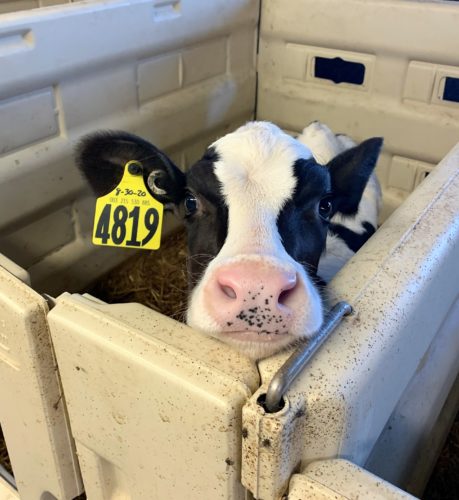Milk Balancers and Fortifiers – What’s the Difference?
Posted: April 1, 2021 | Written By: Anne Proctor, Ph.D., Form-A-Feed Technical Services Specialist

Feeding whole milk to calves makes sense in some dairy operations, but whole milk does not meet all of the calf’s nutritional needs. You might say, “that doesn’t make sense!” believing that the cows of today would not exist had the milk of the ancestral cow not been perfect for her calf. But research shows that calves have requirements for trace minerals and vitamins that are higher than the levels in milk. The modern dairy cow produces milk and grows at a much higher rate than her ancestors did. The addition of balancers and fortifiers to whole milk enable a farmer to bridge the gap between what the cow produces and what the calf needs for optimal growth.
A balancer is used to increase the solids content of the milk, stretch the milk supply and increase the protein-to-fat ratio while also providing vitamins, minerals, feed additives and a coccidiostat. A balancer is like a milk replacer for the fact that it contains protein and fat sources in addition to vitamins, minerals, and additives. The feeding rate is usually 0.25 to 0.5 pounds per head per day but instead of being mixed with water, it is mixed with whole milk. Think of a balancer like a milk cow supplement with protein, VTM and performance supplements. It is added to the TMR to provide protein and energy in addition to nutrients from on-farm ingredients.
Fortifiers are intended to supply the vitamins and minerals that are deficient in milk as well as feed additives and a coccidiostat without bringing in appreciable quantities of protein and fat. Think of a fortifier as a VTM pack for calves. Essentially all the protein and energy come from on farm sources (whole milk). Fortifiers typically have feed rates in the range of 0.02 to 0.05 lb. per head per day. The fortifier balances the VTM portion of the diet and is a carrier for additives like MOS, probiotics, fly control and Bovatec® or Deccox®.
| Balancer | Fortifier | |
| Added to whole milk | Yes | Yes |
| Supplies additional protein | Yes | No |
| Supplies additional fat | Yes | No |
| Changes fat to protein ratio | Yes | No |
| Provides vitamins | Yes | Yes |
| Provides minerals | Yes | Yes |
| Provides fly control | Yes | Yes |
| Provides feed additives | Yes | Yes |
| Feed rate | 0.25-0.5 lb/hd/d | 0.02-0.05 lb/hd/d |
Balancers are a good fit in the following scenarios:
- The solids content of whole milk varies dramatically from day-to-day because of changes in the lactation status and source cows for the milk being collected for calf feeding.
- The amount of milk available for calves varies from day-to-day and taking milk from the tank is not an economical option. Balancers can be a cost-effective way to stretch the milk supply on days where there is not enough milk available for all the calves.
- The farmer wants to get more solids into the calf and is limited in the volume that can be fed per calf.
- Equipment or bottles will not hold more volume.
- Labor utilization does not allow another feeding.
- Poor drainage under pens will result in wet calves and/or additional bedding usage.
- The farmer wants the benefits of feeding additional protein without potential negative effects of also adding more fat.
Fortifiers are a good fit in these situations:
- There is more waste milk available than needed to feed all the calves.
- Waste milk is consistent in fat and protein content from day to day.
- Calves can be fed higher volumes in order to feed more solids.
- Pens have good drainage and additional urine production is not a concern.
- Farmer is concerned about accuracy and mixing errors when adding a coccidiostat, fly control and/or feed additives individually.
Both balancers and fortifiers provide benefits for the health and growth of calves. The right fit depends on each farmer’s situation and goals for his or her calf program. Your Form-A-Feed representative can help you decide if a balancer or a fortifier is the right fit in your whole milk feeding program.